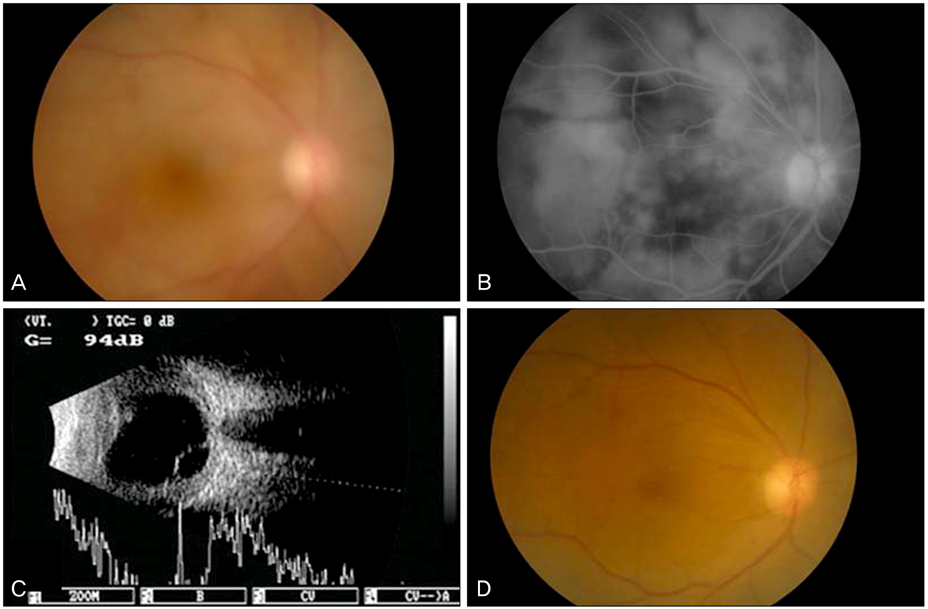Korean J Ophthalmol.
2011 Aug;25(4):282-284. 10.3341/kjo.2011.25.4.282.
Intravitreal Bevacizumab (Avastin) as an Adjuvant for the Treatment of Posterior Scleritis
- Affiliations
-
- 1Department of Ophthalmology, Hallym University Chuncheon Sacred Heart Hospital, Chuncheon, Korea. jiwoneye@hallym.or.kr
- 2Department of Ophthalmology, Hallym University Kangnam Sacred Heart Hospital, Seoul, Korea.
- KMID: 1018419
- DOI: http://doi.org/10.3341/kjo.2011.25.4.282
Abstract
- We report a case of posterior scleritis effectively managed with intravitreal bevacizumab. A 71-year-old woman was diagnosed with posterior scleritis. Although she was initially treated with systemic steroids, her clinical presentation deteriorated. She was then treated with a single intravitreal injection of bevacizumab and aqueous humor collection. The aqueous level of vascular endothelial growth factor prior to the intravitreal injection was 880.51 pg/mL, greater than that in the healthy control group (p < 0.001). One month later, the scleritis was completely resolved, and the patient remained stable during six months of follow-up. Intravitreal bevacizumab appears to be an effective adjuvant therapy for patients with posterior scleritis.
MeSH Terms
-
Aged
Angiogenesis Inhibitors/administration & dosage
Antibodies, Monoclonal, Humanized/*administration & dosage
Aqueous Humor/metabolism
Diagnosis, Differential
Female
Fluorescein Angiography
Follow-Up Studies
Fundus Oculi
Humans
Interleukin-8/metabolism
Intravitreal Injections
Microscopy, Acoustic
Scleritis/*drug therapy/metabolism/pathology
Vascular Endothelial Growth Factor A/metabolism
Figure
Reference
-
1. McCluskey PJ, Watson PG, Lightman S, et al. Posterior scleritis: clinical features, systemic associations, and outcome in a large series of patients. Ophthalmology. 1999. 106:2380–2386.2. Rosenfeld PJ, Moshfeghi AA, Puliafito CA. Optical coherence tomography findings after an intravitreal injection of bevacizumab (avastin) for neovascular age-related macular degeneration. Ophthalmic Surg Lasers Imaging. 2005. 36:331–335.3. Haritoglou C, Kook D, Neubauer A, et al. Intravitreal bevacizumab (Avastin) therapy for persistent diffuse diabetic macular edema. Retina. 2006. 26:999–1005.4. Paroli MP, Teodori C, D'Alessandro M, et al. Increased vascular endothelial growth factor levels in aqueous humor and serum of patients with quiescent uveitis. Eur J Ophthalmol. 2007. 17:938–942.5. Abu El-Asrar AM, Struyf S, Descamps FJ, et al. Chemokines and gelatinases in the aqueous humor of patients with active uveitis. Am J Ophthalmol. 2004. 138:401–411.
- Full Text Links
- Actions
-
Cited
- CITED
-
- Close
- Share
- Similar articles
-
- The Effect of an Intravitreal Dexamethasone Implant for Refractory Posterior Scleritis
- A Case of Acute Anterior Uveitis Associated with HLA-B27 Positivity after Intravitreal Injection of Bevacizumab
- The Change of Microaneurysm in Diabetic Retinopathy Patients Who Undergo Intravitreal Avastin (Bevacizumab) Injection
- Effects of an Intravitreal Bevacizumab Injection Combined With Panretinal Photocoagulation on High-Risk Proliferative Diabetic Retinopathy
- Intravitreal Bevacizumab Injection as Preoperative Adjuvant of Vitrectomy for Proliferative Diabetic Retinopathy


